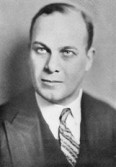Leslie John Comrie
Born August 15, 1893, Pukekohe, New Zealand; died December 11, 1950, London, England; developer in 1930 of mathematical tables for the British Nautical Almanac Office using punched-card bookkeeping machines and who, in that decade, established the first commercial calculating service in Great Britain. [See Wilkes' comments on Cornrie's contributions to the construction of tables in his biography of Charles Babbage: Wilkes, M.V., "Babbage's Expectations for His Engines," Ann. Hist. Comp., Vol. 13, No. 2, pp. 141-146.]

Education: BA, chemistry, University College, Auckland, New Zealand, 1915; MA, chemistry, University College, Auckland, New Zealand, 1916.
Professional Experience: assistant professor, mathematics and astronomy, Swarthmore College, Swarthmore, Pa., 1923-1924; assistant professor, astronomy, Northwestern University, Evanston, Ill., 1924-1925; deputy director, Nautical Almanac Office, 1925-1931, superintendent, 1931-1936; founder and director, Scientific Computing Service, 1936-1950.
Leslie Comrie had begun his professional life as a chemist in Pukekohe and Auckland, New Zealand, when World War I broke out, during which he served in France in the New Zealand Expeditionary Force. He was invalided out of the force, having lost a leg; he turned to a past interest in astronomy, and became a research student at St. John's College, Cambridge, in 1918 with a University Expeditionary Force scholarship. While there he developed a means for the application of new computational techniques to the problems of spherical astronomy, which he carried forward into his later appointment as the deputy superintendent of the Nautical Almanac, for the British Navy (the Admiralty) in London. Later as superintendent he modified the almost one-hundred-year-old Almanac and introduced the concept of a standard equinox" (Comrie 1926 and 1929).
He left the Admiralty in 1934 to found the Scientific Computing Service, where he was able to better apply his ideas of mechanical computation for the preparation of mathematical tables. Using card processing systems he prepared the way for the electronic computer, which he would observe shortly before his death in 1950.
In May 1946 Leslie Comrie returned from a visit to the US with a copy of von Neumann's First Draft of a Report on the EDVAC. Maurice V. Wilkes, later developer of the EDSAC at the University of Cambridge, was given the opportunity of one night in which to read and digest the document which described the stored-program computer concept. Wilkes "recognized this at once as the real thing, and from that time on never had any real doubt as to the way computer development would go. " [See also the biography of Maurice Wilkes]
Wilkes has credited Comrie with providing some of the enthusiasm for mechanical computational techniques which would affect the Cambridge Mathematics Laboratory and later the Computer Laboratory.
In 1982 the Annals of the History of Computing provided the following anecdote about Leslie Comrie:
Comrie, who has lost a foot [sic] during World War I, was in the habit of unscrewing his artificial limb when he came home in the evening to relax and listen to the BBC. On one of those evenings he heard an announcement on the radio that the Works Project Administration (WPA) was to be ended; with it, he realized, would come the demise of the Mathematical Tables Project (MTP). Without stopping to put on his artificial limb, he hopped to the nearest telegraph office and wired President Roosevelt to save the MTP.
There was no way to verify the story, Ira Rhodes said, but a few days later their loft in New York City was visited by a group of government people who gave the appearance of not really knowing what they were doing there. Shortly thereafter, the MTP, instead of ceasing to exist, was made part of the National Bureau of Standards of the US Department of Commerce. [Tropp 1982.]
QUOTATION
Sadler (1980) said: "Comrie, with no claim to be a mathematician, had the clarity of mind, tenacity of purpose, scientific courage, and immense energy that enabled him, by using essentially simple and direct methods, to obtain practical solutions to many problems that defied theoretical analysis. But he was inclined to impatience with those who did not share his devotion to perfectionism, and this led to some difficult personal relationships."
BIBLIOGRAPHY
Biographical
Greaves, W.M.H., "Leslie John Comrie," Monthly Notices of the Royal Astronomical Society, Vol. 113, 1953, pp. 294-304.
Massey, H.S.W., "Leslie John Comrie," Obituary Notices of Fellows of the Royal Society, Vol. 8, 1952, pp. 97-107.
Sadler, D.H., "Comrie, Leslie John," in Gillispie, C.G., ed., Dictionary of Scientific Biography, Vol. 3, Charles Scribner's Sons, New York, 1980, pp. 373-374.
Tropp, Henry. S., "Leslie John Comrie," Anecdotes Dept., Ann. Hist. Comp., Vol. 4, No. 4, Oct. 1982, pp. 371-372.
Significant Publications
Comrie, Leslie John, "The Use of a Standard Equinox in Astronomy," Monthly Notices of the Royal Astronomical Society, Vol. 86, 1926, pp. 618-631.
Comrie, Leslie John, "Explanation," The Nautical Almanac and Astronomical Ephemeris for 1931, London, 1929.
Comrie, Leslie John, "Interpolation and Allied Tables," The Nautical Almanac and Astronomical Ephemeris for 1937, London, 1936.
Comrie, Leslie John, Barlow's Tables of Squares etc. of Integral Numbers up to 72,000, London, 1947.
Comrie, Leslie John, Chamber's Six-figure Mathematical Tables, London, 1950.
UPDATES
Portrait added (MRW, 2012).
New content Copyright © 2013-2023 by the IEEE Computer Society and the Institute of Electrical and Electronics Engineers Inc.
All rights reserved. This material may not be reproduced or redistributed without the express written permission of the copyright holder.
